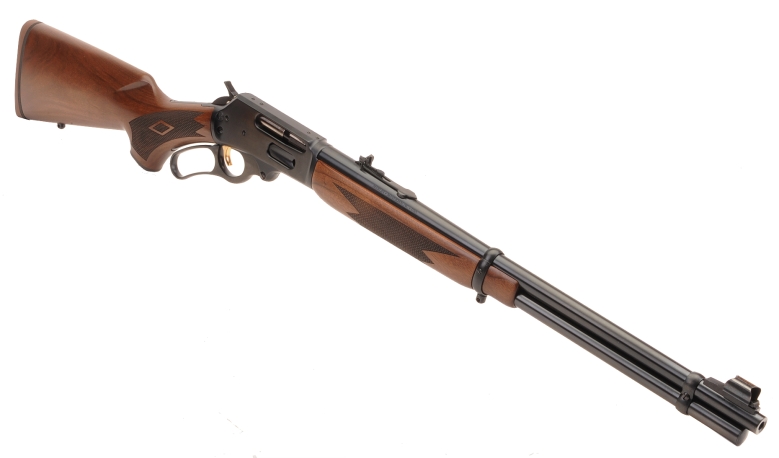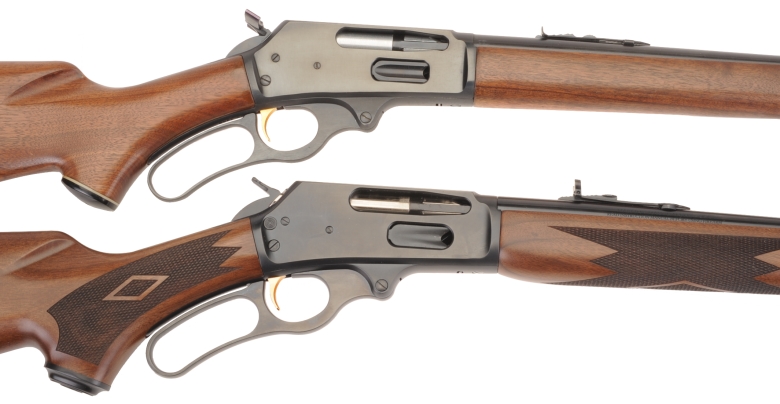01/14/2024 – Maine weather is playing “Got your nose” with me. Ready for as much snow as mother nature can toss at us norther tribe dwellers, we are now getting windstorms that topple trees and snow melts that cause flooding. That’s OK. The tree fall is next winter’s firewood, and I live uphill from my less fortunate neighbors.
However, even a pitiful 8″ snowfall can do some damage when the temperature pops up to 43°f, there is torrential rainfall and all of the snow melts in the span of a few hours. Our 300′ well burped granite silt for two weeks following the last storm, and I have been flushing out filters and water tanks ever since. But enough about my exciting life….
Old and new Marlin Model 336 Classic saddle carbines
I’m not sure when Marlin, of any origin, stopped applying the term “saddle carbine” to the Model 336. Scabbards are readily available, and I suspect there are a good number of people on horseback traveling into remote hunting and camping destinations.
I am sure, even in the ’50s and ’60s, the term “saddle carbine” was not intended to define a wide spread application, as much as it was an effort to draw an association with the old west and American tradition.
The current generation Marlin rifles, as manufactured by Ruger, is actually closer to the original Model 336 Classic than the final decade of production from the old Marlin company that was purchased by Remington and, certainly, Remington’s attempts at manufacturing the product line. Today’s Marlin is more slender gun, more compact… it feels like a saddle carbine in form, weight and balance.
The new generation Marlins are also different than classic Marlin rifles. Marlin’s Microgroove rifling was introduced in their centerfire rifles in 1956. The .30 caliber groove and land count changed a bit between introduction and 1968, when it settled in at 12 grooves 1).
My 1957 30-30 WCF Marlin, appearing in Part I, has 22 groove Microgroove with a 1:10″ twist. The new generation is more traditional rifling, 6 groove, with 1:12″ twist. I would like to say I favor the 1:10″, but I don’t care for the 22 groove when it comes to lead and copper fouling. I am one of those rare birds who does not enjoy bore scrubbing.
Additionally, the 22 groove 1:10″ has not proven to be more accurate than the current. Bullet rotational speed needs to go up as bullet length increases. A 30-06 Spring field with spire tip, longer and heavier bullets may need a 1:10 twist. The 30-30 WCF with its array of stubby flat tip and round nose bullets apparently does not. Winchester Model 94s in 30-30 WCF have always been 1:12″ twist guns.
They are quite different guns…
My own Marlin had been reblued by the old Marlin company, circa 1968. I was away in the military, and someone at my parent’s home… a younger sister, put the Marlin in a damp basement where it picked up some surface rust. To their credit, Marlin refinished it cleanly and didn’t charge me a penny.
When it came back, the walnut was given a satin refinish with Lin-Speed; six coats, finger application, rubbed out with steel wool, then with a felt pad and rotten stone. It still looks good, and it is a tough finish.
The new generation Marlin has a tough poly satin finish. The American black walnut stock is very dark, really nicely contoured and finished, and no “Yipes Stripes” white spacers that were all the rage in the 1950’s and 1960’s. The effects of CNC machines, metal and wood finishing, can be seen in flush inletting at the receiver tang and other edges where wood meets metal. Clearly evidence of precision is demonstrated with accuracy.
The old gun’s metal parts are classically hot blued, not unlike a fine rust blued finish. The current Marlin finish looks a bit… thicker. Listed as satin blue, it is a very deep satin black, which goes really well with the darker walnut. Metal parts that were forged on the old gun, like receiver, locking bolt and breech bolt, remain forged, and treated to more modern manufacturing processes.
Shooting performance differences..
This past week, the 1957 Marlin 336C was shot. Ambient temperature was 8° colder, at 17°, than the range time spent with the current generation Model 336C. I have no idea what the exact change in ambient temperature had on performance, although at a 8° difference, I doubt it would be much. Of the powders utilized in Part I, only Alliant AR Comp is advertised as temperature insensitive.
The handloads shot in both guns were processed and assembled concurrently, so same draw on components, same steps and same guy cranking the press handle. The chronograph was parked on the same tripod points and the muzzle was 10′ from the front chronograph photocell.
| Bullet Type | Bullet Grains |
Powder Type | 1957 Marlin MV FPS |
5 Shot Group ” 100 Yards |
2023 Marlin MV FPS |
5 Shot Group ” 100 Yards |
2023 Marlin MV FPS |
2023 Marlin Group” |
| Prvi Partizan SP | 110 | Trail Boss | 1566 | 2.4 | 1631 | 1.6 | +65 | -0.8 |
| Prvi Partizan SP | 110 | Alliant Reloder 7 | 2498 | 2.2 | 2674 | 1.7 | +176 | -0.5 |
| Prvi Partizan SP | 110 | Alliant Reloder 10x | 2464 | 2.0 | 2548 | 1.6 | +84 | -0.4 |
| Average |
2176 |
2.2 |
2284 |
1.6 |
+108 |
-0.6 |
||
| Barnes XFN | 150 | Alliant AR Comp | 2128 | 1.7 | 2243 | 0.9 | +115 | -0.8 |
| Barnes XFN | 150 | IMR 3031 | 2130 | 2.3 | 2231 | 1.2 | +101 | -1.1 |
| Barnes XFN | 150 | Hodgdon CFE223 | 2234 | 2.0 | 2367 | 1.0 | +133 | -1.0 |
| Average |
2164 |
2.0 |
2280 |
1.0 |
+116 |
-1.0 |
||
| Remington RNSP | 150 | Alliant AR Comp | 2300 | 2.1 | 2423 | 1.1 | +123 | -1.0 |
| Remington RNSP | 150 | IMR 3031 | 2355 | 1.6 | 2408 | 0.7 | +53 | -0.9 |
| Remington RNSP | 150 | Hodgdon CFE223 | 2294 | 1.9 | 2420 | 0.9 | +126 | -1.0 |
| Average |
2316 |
1.9 |
2417 |
0.9 |
+101 |
-1.0 |
||
| Sierra FN | 150 | Alliant AR Comp | 2285 | 1.6 | 2424 | 0.7 | +139 | -0.9 |
| Sierra FN | 150 | IMR 3031 | 2331 | 1.5 | 2484 | 0.5 | +153 | -1.0 |
| Sierra FN | 150 | Hodgdon CFE223 | 2376 | 2.1 | 2485 | 1.1 | +109 | -1.0 |
| Average |
2331 |
1.7 |
2464 |
0.8 |
+134 |
-1.0 |
||
| Hornady FTX | 160 | Alliant AR Comp | 2243 | 1.7 | 2370 | 0.6 | +127 | -1.1 |
| Hornady FTX | 160 | IMR 3031 | 2218 | 1.9 | 2351 | 0.8 | +133 | -1.1 |
| Hornady FTX | 160 | Hodgdon CFE 223 | 2319 | 1.9 | 2394 | 0.7 | +75 | -1.2 |
| Average |
2260 |
1.8 |
2372 |
0.7 |
+112 |
-1.1 |
||
| Remington RNSP | 170 | Alliant AR Comp | 2117 | 2.0 | 2234 | 0.6 | +117 | -1.4 |
| Remington RNSP | 170 | IMR 3031 | 2163 | 1.9 | 2248 | 1.0 | +85 | -0.9 |
| Remington RNSP | 170 | Hodgdon CFE 223 | 2144 | 1.3 | 2331 | 0.9 | +187 | -0.4 |
| Average |
2141 |
1.7 |
2271 |
0.8 |
+130 |
-0.9 |
||
| Sierra Pro-Hunter FNSP | 170 | Alliant AR Comp | 2077 | 1.6 | 2212 | 1.1 | +135 | -0.5 |
| Sierra Pro-Hunter FNSP | 170 | IMR 3031 | 2175 | 1.9 | 2279 | 0.8 | +104 | -1.1 |
| Sierra Pro-Hunter FNSP | 170 | Hodgdon CFE223 | 2168 | 1.6 | 2227 | 0.6 | +59 | -1.0 |
| Average |
2140 |
1.7 |
2239 |
0.9 |
+99 |
-0.9 |
||
| Average Of All |
2218 | 1.9 | 2333 | 1.0 | +114 | -0.9 |
The first pass at the table only included overall average numbers, but that was too much of a broad stroke, so averages by bullet type were added. For this small sample of bullets and handloads, I can’t say one powder yielded the highest or lowest velocity gains, particularly since accuracy with any given combination was the objective, not maximum velocity.
I think I can conclude that the current Marlin produced, on the average, +100 fps muzzle velocity over the old Marlin, and group sizes about half that of the 1957 Marlin. I am very attached to my old Marlin for all of the reasons previously indicated, but I believe the current Marlins go a long ways toward enhancing Marlin brand reputation and better serving today’s hunters.
1) “Marlin’s Microgroove Barrels”, Glen E. Fryxell and “Marlin Firearms: A History of the Guns and the Company That Made Them, William S. Brophy



Wow! That’s quite a difference in group size. I may just need to retire my 20yo 336 and buy one of the new production rifles as my go-to woods rifle!
I find the slim forestock of the older model more attractive than the “pregnant” forestock of the new one. My 336 has one of the pregnant forestocks as well. I’m curious about your thoughts on the differences, or if it is even something that caught your eye?
Yes, I like the thin stocks also.
The stocks were a point of discussion while the designs were under review at Ruger. Both buttstock and forearms were thinned approximately 1/4″ side to side, most noticeable where forearm meets the receiver. Additionally, the bottom side was given a more shallow taper where it rises to the receiver, I probably should put them side by side and take measurements.